Anderson's Tradescantia - content features
In home floriculture, Anderson's Tradescantia takes pride of place. A herbaceous plant native to America has several ornamental varieties that are successfully cultivated in our country. The cultivar was named after the American botanist Anderson. Consider what a flower looks like, what kind of care it needs in an apartment.
- general characteristics
- Varieties
- Max double (Macs Double)
- Innocence
- Red Grape
- Concord grape
- Karminglut
- Sweet Kate
- Merlot Clusters
- Bilberry Ice
- Pink Chablis
- Osprey
- Purchase and adaptation
- Landing
- Growing conditions
- Choice of soil and location
- Humidity
- Lighting
- Temperature
- Care features
- Watering
- Top dressing
- Pruning
- Transfer
- Reproduction methods
- Seeds
- Cuttings
- By dividing the root
- Diseases and pests
- Useful videos
- Healing properties
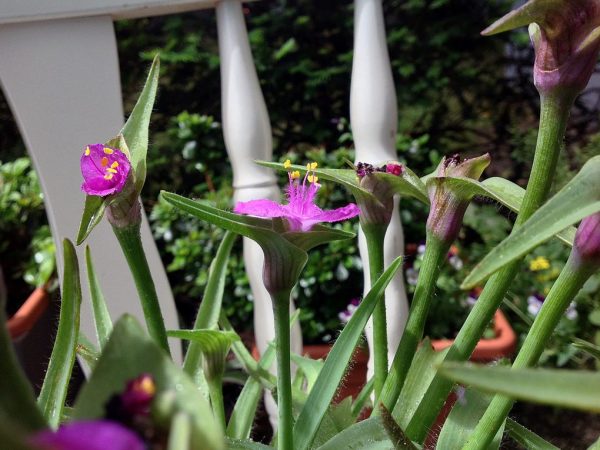
Anderson's Tradescantia
general characteristics
The plant of the Kommelinovy family has received two names among the people - the Virginian spider or Anderson's spider.
An evergreen upright shrub with fleshy, sticky shoots. Height, depending on the variety, varies from 30 to 60 cm. The leaves are curved, long. Inflorescences are small, 2.5-3 cm in diameter. Flowers are located on pedicels, collected in bunches. Outwardly, they resemble the shape of an umbrella.
Long flowering - lasts from 1.5 to 2 months.
Varieties
Thanks to the efforts of breeders, many unique and vibrant varieties have been bred with different shades of inflorescences and bush heights.
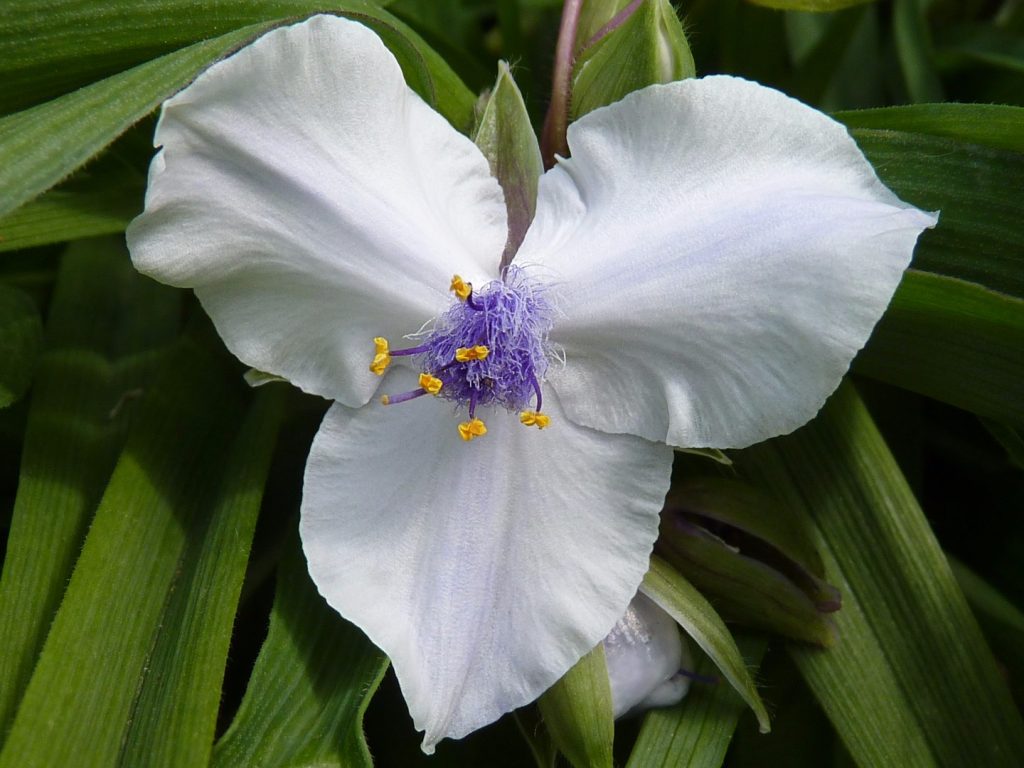
Tradescantia Anderson photo
Max double (Macs Double)
A beautiful flower with green long leaves, erect fleshy stems. At the top of the shoots, terry lilac inflorescences bloom. In the center there is a miniature flower on a thin purple stem, the top is yellow.
The variety is suitable for indoor and outdoor cultivation in regions with warm climates.
Innocence
Miniature Tradescantia 30-40 cm high, with beautiful leaves, pointed at the tips. The color of the leaf plate is green, length 15-20 cm, width 3-4 cm.
The variety is distinguished by lush and abundant flowering - the inflorescences consist of three petals in a light lilac tone. In the center there is a slight pubescence and threadlike flowers of a yellow hue.
Red grape
A very bright look with raspberry flowers, which bloom several pieces at once on each shoot.
The stems are massive, 35-40 cm long, the leaves are elongated, dense with a slight pinkish edging. The core of the flowers contains yellow stamens, which give them an unusual contrast.
Concorde Grape (Concord grape)
A beautiful densely leafy tradescantia with belt-like leaves of a bright green tone. Stems are erect, dense, small three-lobed flowers of a bluish-blue color bloom at their apex. Diameter - 3-4 cm.
Long bloom - a little more than 1.5 months.
Karminglut
This variety blooms with raspberry inflorescences, 3-4 cm in size. Stems are straight, thin, strewn with flowers on top.
The main difference is the silvery shade of the leaves.The length of the leaf plate is 12-15 cm, the shape is elongated, the surface is slightly rough.
Sweet Kate
This variety has flowers of a bluish-lilac shade, small, with a circumference of 2-3 cm, three-lobed. The leaves are long (15-20 cm), yellow or light green. This combination of tones gives the plant a rich contrast and attractiveness.
Merlot Clusters (Merlot Clusters)
One of the most decorative hybrids with variegated inflorescences. The stem is erect, green. The lower part is densely leafy. Leaves of a rich emerald tone, belt-like, sharp at the tips, drooping.
At the stage of budding, purple buds are formed at the top of the shoots from which three-lobed white inflorescences with a bluish center bloom. Below the petals are dark purple.
Billberry Ice (Bilberry Ice)
Delicate plant with emerald, elongated foliage and thin stems growing to the top. On each shoot, several inflorescences are formed, collected in a bunch. The flowers are small, 3-4 cm in diameter, three-lobed, composed of light pink petals, closer to the center, the color is a couple of shades darker.
Pink Chablis Chablis)
Decorative, compact flower - height 20-30 cm with belt-like, long leaves of green color.
On each shoot, one inflorescence of a pale pink or light purple shade with a lilac core blooms.
Osprey (Osprey)
It differs from other varieties in snow-white buds. The circumference is 3-4 cm. The core is pubescent, purple. Leaves are elongated, green, stems are erect, strong.
Purchase and adaptation
You can buy any sort of Anderson's Tradescantia from a florist's shop. It is better to take flowering specimens - this is a sure sign of their quality and health. In addition, by the inflorescences you can see that this is a real variety.
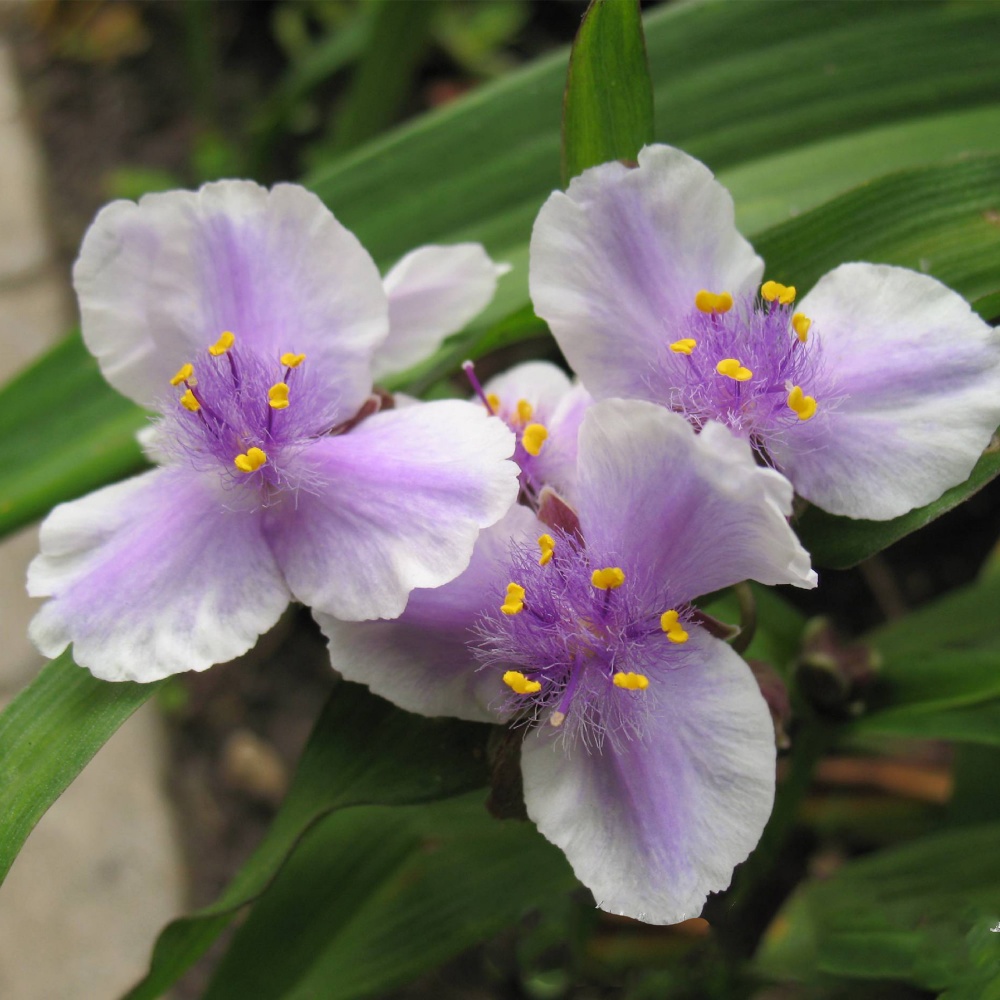
Anderson's Tradescantia Billberry Ice
Examine carefully the aerial part - it is important that there are no signs of diseases and pests (growths, blotches of an unnatural color) on the stems, leaves and buds.
The substrate should be slightly damp, fresh, without acidification and mold on the surface.
The purchased plant is placed in a well-lit place and preferably away from other flowers. Keeping in quarantine for three weeks will help him not only adapt to indoor growing conditions, but also identify if he has any diseases, harmful insects. After it is transferred to a common room with all the vegetation.
Landing
Can be planted in any high container with drainage holes. A ceramic or plastic pot is suitable.
Expanded clay or pebbles are laid at the bottom to ensure a good outflow of excess moisture, then fertile soil. The root system is lowered, straightened, covered with the remaining soil mixture to the top, crushed around the stem and watered with warm water.
Growing conditions
Choice of soil and location
Tradescantia prefers to grow in slightly acidic soil. You can use a sandy substrate with the addition of peat, black oily clay and rotted sawdust, mixed in a 1: 2: 1: 0.5 ratio.
She loves diffused daylight, so it should be placed on the west or southwest side of the house. When grown on a northern or eastern windowsill, artificial lighting will be required - without it, the plant will become faded, and the flowering will not be so abundant and bright.
You can also install a flowerpot on the south window, but at the same time provide protection from the scorching rays at lunchtime. If this condition is not met, the plant can quickly burn and dry out.
Humidity
The flower prefers to grow in moderate humidity conditions. Irrigation of the crown is necessary only on hot summer days to prevent wilting of stems, leaves and the appearance of spider mites. If the air in the room is too hot and dry, you can install an open vessel with water next to the flowerpot, place the pot on a pallet with wet expanded clay.
In winter, Tradescantia is irrigated 1-2 times a month for hygienic purposes.
Lighting

Anderson's Tradescantia Osprey
Tradescantia requires diffused daylight for at least 8 hours a day. In spring and summer, the flower is kept outdoors (placed on a balcony, terrace, loggia, or placed in a shaded place in a flower garden).
In winter, when kept on windows with insufficient lighting, artificial additional lighting with a fluorescent lamp will be required. You cannot keep the plant in the sun, its leaves and inflorescences will quickly burn out and it will die.
Temperature
In the phase of active growth and flowering, stable heat is required within the range of 20-26 ° C. In winter, when the dormant period begins, it is lowered to 15-17 ° C.
Tradescantia does not tolerate drafts, therefore, at the time of airing the room in the cold season, it must be moved to another room.
Care features
This is an unassuming culture to care for, so everyone, even a beginner, can grow it.
Watering
This is a moisture-loving plant, therefore it does not tolerate drought. Water it sparingly, after the substrate dries to a depth of 3-4 cm.
For irrigation, use filtered or settled water at room temperature. The excess moisture accumulated in the pan is poured out.
After wetting, surface loosening can be carried out to maintain the moisture and breathability of the soil.
Top dressing
The first feeding is given in early spring, when the flower wakes up. Usually, mineral compositions are used for herbaceous ornamental flowering plants. They are introduced in liquid form - once a month.
At the budding stage, it can be fertilized with preparations containing potassium. This component promotes lush, vibrant and long-lasting flowering. Fertilize every 10 days.
Pruning
Formation for this culture is not needed, because it initially forms a compact and dense bush.
A sanitary haircut is required every spring and autumn - all shoots, leaves that have dried up, turned yellow, rotted or damaged by parasites are cut out. Also, after the end of flowering, it is worth cutting off the wilted buds - they only take away the strength and energy from the flower.
Transfer
The frequency of transplanting home flowers is once every three years.
It is also necessary to transplant a purchased plant, because the soil in which it was sold does not contain substances useful for development and growth. You can transplant only after the end of flowering.
The procedure is carried out by the method of transshipment of an earthen coma - at first it is watered abundantly, then removed and placed in a new pot. It should be 2-3 cm in diameter larger than the previous one. All voids are filled with a nutritious substrate, tamped, moistened.
Flowers need to be transplanted, in which the root system has begun to rot from overflows, or damaged by infections, pests. In this case, the Tradescantia is first watered, then removed and lowered into a basin of water to completely wash off the soil. Rotten roots are cut out to healthy tissue, treated with a fungicide, dried, and planted in separate pots.
Reproduction methods
There are several ways how this indoor flower can be propagated, each with pros and cons.
Seeds
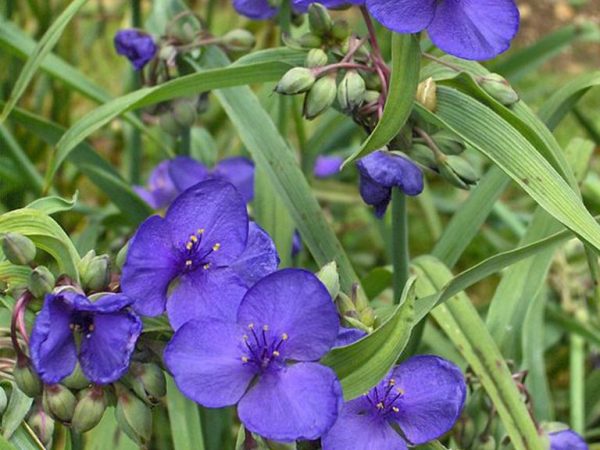
Tradescantia Anderson Innosens
The seeds collected at the end of flowering are soaked in water for 24 hours, then sown in bowls. For sowing, a mixture of peat and sand (1: 1) is used. Seedlings are moistened with a spray bottle, covered with transparent glass. Until the moment of germination, they are periodically watered, ventilated every day.
After the mass emergence of seedlings, the glass is removed, they continue to grow and look after. At the stage of development of one pair of leaves, they are seated in separate pots.
Cuttings
This is the simplest and most effective breeding method. Cuttings are cut from the apices of the stems after flowering. The cut off places are sprayed with Epin to speed up the rooting process, immersed in a peat-sand mixture to a depth of 3-4 cm, watered, covered with a film.
After 14-20 days, they will begin to release new leaves, then the shelter is removed. After 4 weeks, planting is carried out in separate flowerpots.
By dividing the root
To do this, use an old plant that needs to be rejuvenated. It is watered, removed from the pot, washed off the remnants of the soil with water. Divide into several parts, so that each division has one shoot and 2-3 roots. Places of cuts are sprinkled with charcoal, seated separately in flowerpots.
Diseases and pests
This indoor plant has several parasites and sores that lead to the loss of decorativeness and death.
| Diseases and pests | Signs | Treatment | Prophylaxis |
| Thrips, spider mites, scale insects | They feed on the juice of leaves, stems, buds. The affected areas turn yellow, dry out and die off | Treatment with Aktellik, Aktara, Fitoverm or Karbofos | Maintaining temperature and humidity at the right level, using a sterile substrate for planting and transplanting, buying healthy plants |
| Root rot | The reason is frequent waterlogging with cold water. First, the root rots, then the stem becomes wet, soft, blackens | The flower is disposed of, at the top, the cutting is separated for rooting. | Avoid overflow |
Useful videos
Healing properties
The stems and leaves of Anderson's Tradescantia have unique medicinal properties:
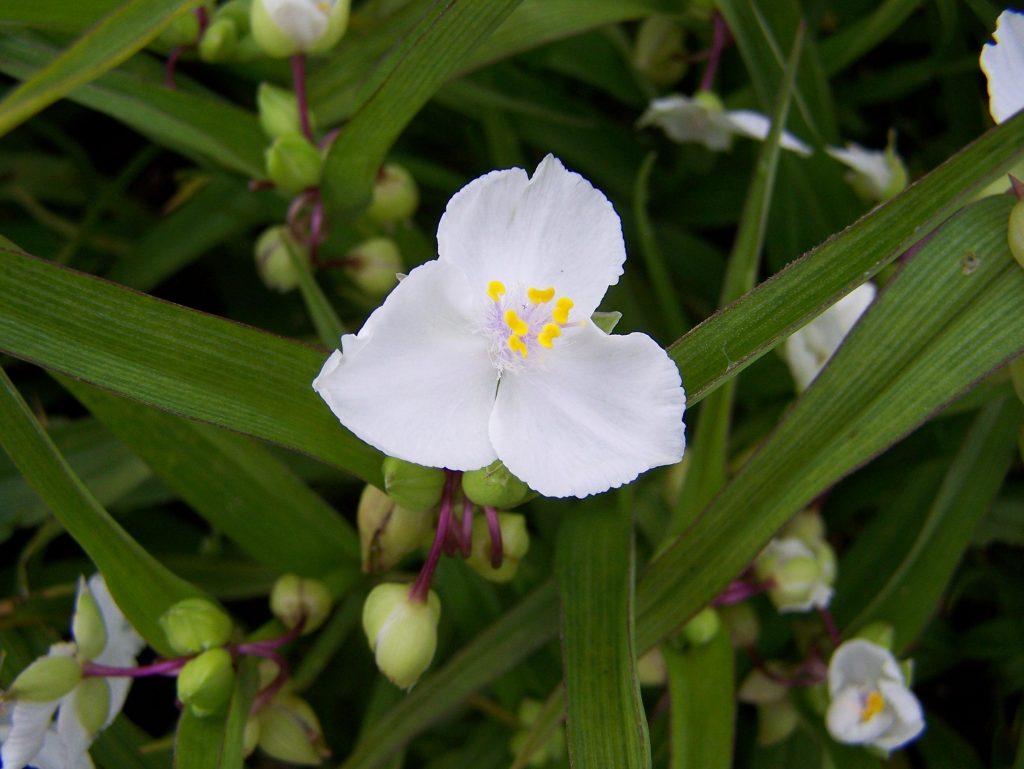
Anderson's Tradescantia Max Double
- stop bleeding;
- promote rapid healing of wounds, cracks, abrasions;
- preparations based on this plant are used in the complex treatment of tuberculosis, colds, gastrointestinal tract;
- juice from the leaves helps to get rid of periodontal disease.

